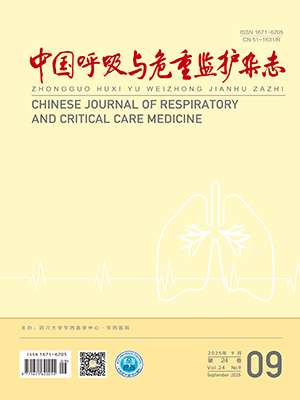| 1. |
沈海芬, 张海英. 脑外伤患者气管切开后不同黏稠度痰液适宜吸痰负压的临床研究. 中华护理杂志, 2009, 44(8): 694-697.
|
| 2. |
赖士群, 伍雪艳, 梁伟霞, 等. 吸入性损伤气管切开病人吸痰方法探讨. 护理研究, 2010, 24(19): 1721-1722.
|
| 3. |
单亮. 气管切开时机对危重患者临床预后影响的 meta 分析. 济南: 山东大学, 2013.
|
| 4. |
陈元杰, 孙琳, 彭琳, 等. 高流量湿化氧对危重患者脱机后呼吸功能的保护作用. 中国呼吸与危重监护杂志, 2018, 17(3): 259-262.
|
| 5. |
燕朋波, 全金梅, 李志静, 等. 三种不同气道湿化方法对建立人工气道脱机患者效果研究. 中国呼吸与危重监护杂志, 2014, 13(5): 480-483.
|
| 6. |
白二灵. 浅谈气管切开术后的护理体会. 世界最新医学信息文摘, 2015, 15(19): 152-153.
|
| 7. |
Sztrymf B, Messika J, Bertrand F, et al. Beneficial effects of humidified high flow nasal oxygen in critical care patients: a prospective pilot study. Intensive Care Med, 2011, 37(11): 1780-1786.
|
| 8. |
Sztrymf B, Messika J, Mayot T, et al. Impact of high-flow nasal cannula oxygen therapy on intensive care unit patients with acute respiratory failure: a prospective observational study. J Crit Care, 2012, 27(3): 324.
|
| 9. |
Lenglet H, Sztrymf B, Leroy C, et al. Humidified high flow nasal oxygen in the emergency department: feasibility and interest. Respiratory Care, 2012, 57(11): 1873-1878.
|
| 10. |
蓝惠兰, 邓旭萍, 陈瀚熙, 等. 机械通气呼吸湿化器湿化研究进展. 护理学杂志, 2013, 28(13): 94-97.
|
| 11. |
肖凌月. 人工鼻和呼吸机湿化器用于经人工气道行机械辅助通气病人的临床研究. 护理研究, 2010, 24(1): 209-210.
|
| 12. |
江方正, 李雪, 叶向红, 等. 持续加温湿化氧疗在气管切开患者脱机中的应用. 中华护理杂志, 2011, 46(2): 128-130.
|
| 13. |
姜超美, 白淑玲, 王辰, 等. 人工气道后痰液黏稠度的判别方法及临床意义. 中华护理杂志, 1994, 29(7): 434.
|
| 14. |
中华人民共和国卫生部. 医院感染诊断标准(试行). 中华医院感染杂志, 2001, 36(8): 495.
|
| 15. |
黄维明, 谢春雷, 李春霞, 等. 神经外科重症监护病房气管切开患者肺部感染的目标性监测和干预. 中华现代护理杂志, 2011, 17(32): 3911-3913.
|
| 16. |
郭润玲, 郭爱芝, 王颖, 等. Venturi+MR50 氧疗在气管插管患者拔管中的应用. 护理研究, 2014, 7(7C): 2636-2637.
|
| 17. |
赵彦卓, 魏琼. 呼吸湿化治疗仪在气管插管患者脱机后的应用. 临床误诊误治, 2016, 29(S1): 100-101.
|
| 18. |
李威, 吴迪迪, 黄思语. 机械通气患者脱机后应用 IRVO2 呼吸湿化治疗仪、Stellar100 无创呼吸机疗效观察. 新疆医学, 2017, 47(5): 492-494.
|




